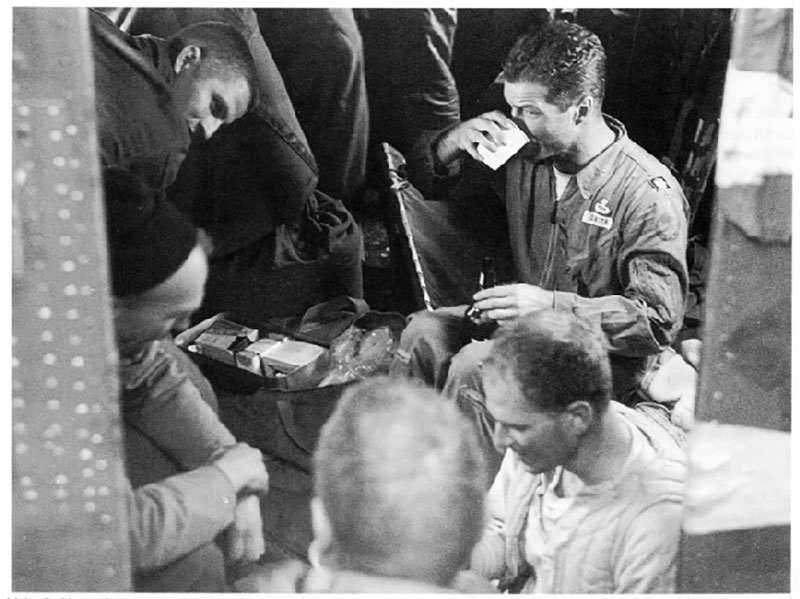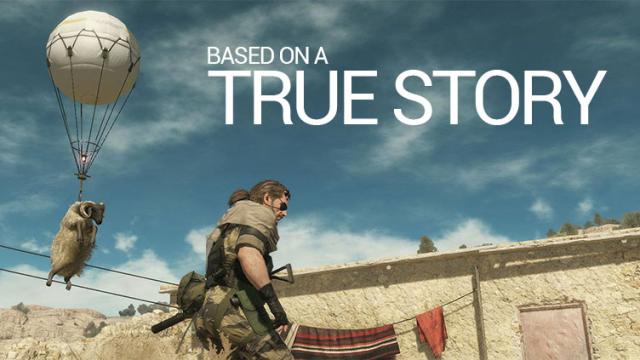I’ve never really liked Metal Gear games, but I am loving Metal Gear Solid V so far. Not for the story, though, or the stealth. Mostly for the balloons.
Not since Armed and Dangerous’ Land Shark Gun has a video game tool been so funny and practical at the same time. You can steal jeeps! Kidnap soldiers! Get sleeping bad guys off the battlefield!
And did you know your horse uses one at the end of every mission? It’s how he gets home!
Like a lot of fancy military tech in Metal Gear games, there’s truth behind Kojima’s wackiness. The game’s fulton balloons are, from the name to their use, a tribute to one of the coolest pieces of actual Cold War spy gear, the Fulton surface-to-air recovery system, or STARS. It’s also commonly referred to as the “Skyhook” system.
Made kinda-famous by James Bond in 1965’s Thunderball (above), STARS was created and developed in the 1950s by Robert Edison Fulton, Jr., an old-school adventurer (he rode a motorbike from London to Tokyo!) and inventor. While working on another weird project (a flying car), Fulton had pondered how a person needing to be airlifted could be extracted if they were stuck somewhere neither aircraft or helicopters could land.
Fulton worked with the CIA to tackle this challenge, the Agency recognising the value in getting agents off the ground and into an aircraft as quickly as possible, without the aircraft having to land. This not only avoided the need for an aircraft to expose itself to danger, but would allow the extraction of an agent from almost anywhere.
Fulton’s idea involved attaching a balloon to somebody, having that balloon lift them into the sky and then having an aircraft “scoop” them up once they reached a certain altitude.
Throughout the 1950s, Fulton tested STARS with weights, dummies and various aircraft on the way to developing a workable system, while the CIA secretly did its own testing — on humans — using a simpler design.
If you think sticking balloons onto animals in MGSV is weird, consider this: one of the last tests Fulton performed on his design involved a pig, and went…well, the CIA tells it like this:
Fulton first used instrumented dummies as he prepared for a live pickup. He next used a pig, as pigs have nervous systems close to humans. Lifted off the ground, the pig began to spin as it flew through the air at 125 mph. It arrived on board undamaged but in a disoriented state. Once it recovered, it attacked the crew.
By 1958, Fulton’s research was almost complete. The system recorded its first human pickup in August, and the process had been pretty much finalised: an aircraft would drop a package that contained a harness, a braided nylon line, a helium bottle and a balloon. Someone on the ground would collect this, wear/attach the harness to cargo, inflate the balloon and be shot into the sky. Which was the easy part; an aircraft, normally a C-130 Hercules, would then have to collect the person/package:
The pickup aircraft sported two tubular steel “horns” protruding from its nose, 30 feet long and spread at a 70° angle. The aircraft would fly into the line, aiming at a bright mylar marker placed at the 425-foot (130 m) level. As the line was caught between the forks on the nose of the aircraft, the balloon was released and at the same time the spring-loaded trigger mechanism (sky anchor) secured the line to the aircraft. As the line streamed under the fuselage, it was snared by the pickup crew, using a J-hook. It was then attached to a powered winch and pulled on board. The aircraft also had cables strung from the nose to the wingtips to keep the balloon line away from the propellers, in case the catch was unsuccessful.
STARS saw its first active service in 1962 on Operation Coldfeet when a pair of American agents were retrieved — despite atrocious visibility — following their survey of an abandoned Soviet research base. Below is a shot of one of those agents, Maj. James Smith, celebrating his successful retrieval on-board the specially-modified B-17 that picked him up.

Over the next three decades, STARS was used extensively by the US, not just on CIA missions but by the Air Force and Navy as well. And in spite of fears over how elaborate and dangerous it had appeared (the Navy had such concerns in 1961 that Operation Coldfeet had nearly been cancelled), between 1962 and the system’s demise in the 1990s only a single fatality was recorded.
STARS was phased out in 1996 when the last branch of the services employing it, Air Force Special Operations Command, ceased supporting the tech. As useful as it had been to the US during the Cold War, advances in helicopter range and landing capabilities had rendered STARS unnecessary.
So the next time you’re sticking a balloon to an unconscious sheep and wondering, “what the hell am I doing here, Kojima, you’re crazy”, know that the only crazy thing about Fulton’s invention being in the game was Kojima being smart enough to include something so cool in the first place.

Comments
14 responses to “The Real Story Behind Metal Gear Solid V’s Awesome Balloons”
It was also in The Dark Knight and was in Battlefield 4’s single player.
It was in BF4 campaign? That’s quite telling as to how memorable it was…
And Dead Rising 2+ a number of films.
I lol’d at this, the poor indignant pig. I do love the how the puppy at the beginning of MGSV just so unceremoniously disappears with a howl in to the sky. I’d also probably attack the crew 😛
FYI Naked Snake also used this method of extraction at the end of the Virtuous Mission so this isn’t the first time it’s appeared in MGS.
This.
I’ve been replaying Snake Eater recently, and the Fulton method was mentioned there in the briefing as already having been ‘combat-tested’, which I assumed was some real history from Kojima.
Peace Walker you could fulton people and vehicles.
Yep, Snake Eater predates Peace Walker (and Portable Ops, which also had Fulton).
Could you Fulton in Portable Ops? I thought you had to drag people to the truck or leave them next to allies in the field for pick up..
I could be wrong, but I’m pretty sure it was at least mentioned by name. Either way, Snake Eater definitely had it, and it predates PO 🙂
I love the irony that Operation Coldfeet was nearly cancelled over… getting cold feet.
Why is this so excting now? I feel like I was the only one to play Portable Ops & Peace Walker. Fulton Recovery is so 2010. #hipstertime
Fulton was in Snake Eater! #rehipstered
I think they where using FRS in Balloon Fight on the Nes #rerehipstered
I want someone to make a Fulton Simulator whereby you fly a plane and have to pick up all the stuff Snake fultons from the battlefield.
(I’ve heard that there’s audio in-game indicating a helicopter is used, but an aeroplane would be more challenging).
This explanation of the fulton system fails the bullshit test. A balloon large enough to lift a person would be way to big to use in a stealth op in the field. There’s a reason why we’re not all zipping around in personal balloons all day and its not because that wouldn’t be awesome, because it would. Air is just not that dense and you have to displace a lot of it to equal the mass of a person.
The fulton system is actually way cleverer. The helium balloon is not there to lift the *cargo*. It is there to lift the *line*, which the plane then snares, lifting the cargo which until now has sat comfortably on the ground.